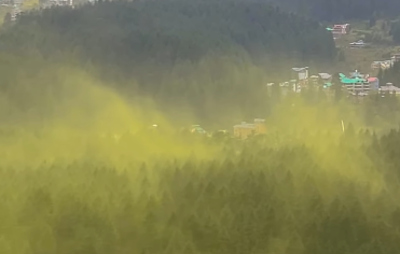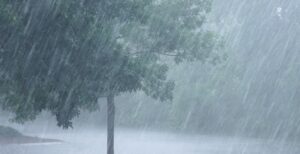Watch the Sky Turn Yellow: Manali Witnesses Stunning Pollen Cloud Phenomenon

Watch the Sky Turn Yellow: Manali Witnesses Stunning Pollen Cloud Phenomenon
Manali, the scenic town nestled in the Himalayas, is currently witnessing a breathtaking natural phenomenon that’s turning heads and capturing hearts. Large clouds of yellow mist have been seen floating gracefully over the valleys, cloaking the region in an ethereal golden hue. At first glance, it might resemble smoke or pollution—but this stunning display is actually a remarkable act of nature.
The golden clouds drifting across the forests are made entirely of pollen, primarily released by pine and deodar trees that dominate Manali’s lush landscape. This fascinating occurrence happens during their flowering season, when the trees emit massive quantities of pollen grains into the air as part of their natural reproductive cycle.
The sudden appearance of these pollen clouds has created a buzz among both locals and tourists. Since the beginning of October, social media has been flooded with viral videos showcasing these surreal, dream-like scenes. As sunlight filters through the clouds of pollen, the valleys appear painted in shades of yellow, giving nature lovers and photographers an unforgettable visual treat.
So why now, and why so much? The timing aligns with the trees’ seasonal rhythm. During this part of the year, conditions in the region—particularly dry weather and mild winds—create the perfect setting for pollen to be released in large volumes and remain airborne. The wind carries the fine yellow grains across vast distances, making them visible as floating clouds.
While the sight is undeniably beautiful, there’s more to it than just its appearance. These pollen grains serve a vital ecological purpose—they enable tree reproduction by fertilizing other plants of the same species. This annual cycle ensures the continued growth of pine and deodar forests, which are essential for the local ecosystem.
But not everything about this golden dust is harmless. For those with pollen allergies or respiratory issues, the air can become a little less welcoming during this time. High concentrations of pollen can trigger allergic reactions like sneezing, watery eyes, nasal congestion, and even asthma flare-ups in sensitive individuals. It’s a reminder that while nature is awe-inspiring, it can also challenge our health in subtle ways.
The intensity of this pollen season varies from year to year. Factors such as temperature, humidity, and wind patterns influence how much pollen is released and how long it stays in the air. This year, the combination of calm weather and dry skies has made the pollen clouds especially visible and persistent.
For travelers heading to Manali during this period, the experience is likely to be one of nature’s most unforgettable displays—provided they take the right precautions. Those prone to allergies are advised to check local pollen forecasts, stay indoors during peak times, use masks when outside, and consult doctors for allergy medications like antihistamines to manage symptoms.












